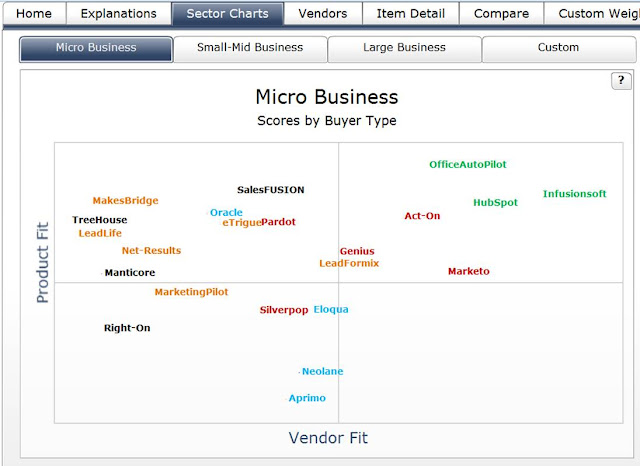One of the most important features of our VEST report on B2B marketing automation systems is that it divides marketing automation users into distinct segments, each having a different set of needs. This matters because the systems all do roughly the same things, making it hard for inexperienced buyers to tell them apart. Many vendors – especially those who target the middle sector – also try to serve all types of companies, adding to the confusion. Where the vendors differ is in the details of how they implement the common features, applying approaches that are generally best suited to one type of marketing organization.
The VEST segmentation is based on company size, as measured by revenue. I’m painfully aware that this isn’t the ideal way to group users, since companies of the same size can still vary greatly in their needs and marketing sophistication. But revenue is objectively measureable and most marketing automation vendors can provide reasonably accurate client counts by revenue group. So we use it as a proxy for the other client differences.
The primary way we report on the different segments is by applying different weights to the same feature in our vendor scoring for each segment. This lets us rank vendors based on how their features and company strengths match against each sector’s needs. A key part of the approach is to penalize vendors with negative weights for features that are too advanced for a particular customer group. So far as I know, no other analysts do this in their scoring. It avoids a common problem with scoring systems, that systems with the most features always win.
The chart above shows our ratings for the micro business sector, defined as companies with under $5 million in revenue. These are very small companies, typically run personally by an owner. They rarely have a full-time professional marketer on staff. Primary marketing interests are group emails, landing pages, and simple lead nurturing through email auto-responders. Before marketing automation, they typically use an email system (which also provides landing pages and simple nurture campaigns) or sales automation product for their marketing. They often do not integrate marketing automation with a separate sales automation system, either because they don’t use one at all or because they rely on CRM features within marketing automation itself. As of July 2012, marketing automation vendors reported more than 17,000 micro-business installations, just over 60% of the industry total. But, because prices are lower than other segments, the segment generates only an estimated 18% of industry revenue, or $65 million for full-year 2012.
Companies in this sector have very limited marketing and technical resources. As a result, their overriding needs are ease of use and a broad range of features within a single product. What they don’t need are very complex campaigns, extensive planning and budgeting, and custom database designs. Our scoring reflects those priorities.
As the chart shows, the leaders in this segment are OfficeAutoPilot, Infusionsoft, and HubSpot. The first two are micro-business specialists; in particular, they have built-in CRM and order processing. HubSpot isn’t quite as highly tailored to this segment, which is why it is a little further from the top than the other two. (The vertical dimension is product fit, which basically means features.) But HubSpot has a very large number of clients in this segment, so it is still quite far to the right. (The horizontal dimension is vendor fit, a combination of customer count, segment concentration, and vendor resources.) Act-On and Marketo also have strong positions in this sector, even though their features – especially in Marketo’s case – are not necessarily the best fit. Again, bear in mind that revenue is a very crude segmentation, so many Act-On and Marketo clients in this group probably have requirements closer to those I’ve assigned to the middle tier.
The other important set of vendors are those at the upper left of the chart: companies with a strong feature fit even though they are smaller than the leaders. SalesFUSION and MakesBridge stand out especially in this group for micro-business users. Oracle‘s presence is, frankly, pretty odd: it’s due to a low per seat price and the vendor’s position that it has a built-in CRM module. In fact, nine of the 22 vendors say they provide a CRM option, which may be technically correct but in most cases probably isn’t realistic. This is even more proof – as if it were needed – that buyers need to explore the products in detail before making a purchase.




